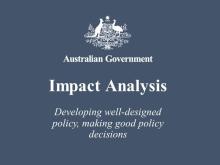By Anna Bull, National Indigenous Australians Agency and others

As we are in the midst of the 2024-25 Budget cycle, it’s important to understand how to meet the various policy impact analysis requirements when drafting New Policy Proposals and Cabinet Submissions.
Impact analysis is a tool for developing well-designed policy, making good policy decisions, and contributes to a robust picture of impacts for decision-makers.
There are a number of impact analysis processes either currently available to drafting agencies or in development, including:
Office of Impact Analysis – Prime Minister and Cabinet
The Office of Impact Analysis (OIA) – formerly the Office of Best Practice Regulation (OBPR) – administers the Australian Government Guide to Policy Impact Analysis, which is based on the OECD’s Regulatory Impact Assessment framework. OIA can provide early advice on whether an Impact Analysis (IA) is required for policy proposals, and if so, whether the Department needs to successfully complete the formal assessment process prior to a decision by Government. The distribution of impacts across affected cohorts is an important element of IA, and OIA will work with Department’s to ensure that linkages and efficiencies with the other impact analysis processes are explored.
Gender Analysis and Gender Impact Assessment Framework – Office for Women
Gender analysis implements the Government’s commitment to putting gender equality at the heart of policy and decision making, and making women’s economic equality a central economic imperative.
All Cabinet Submissions and New Policy Proposals require gender analysis to surface gendered impacts. Where a policy meets set criteria, a more comprehensive Gender Impact Assessment (GIA) is also required. Agencies are required to undertake their own gender analysis and GIA.
The OFW has published Including Gender: An APS Guide to Gender Analysis and Gender Impact Assessment to assist policy drafters undertake gender analysis.
Regional Australia Impact Statement – Department of Infrastructure, Transport, Regional Development, Communications and the Arts
A Regional Australia Impact Statement (RAIS) is designed to help policymakers understand how an NPP will affect regional, remote and rural Australia differently to metropolitan Australia. A RAIS can also set out how an NPP or Submission aligns with the Government’s Regional Investment Framework, which outlines the Government’s approach to how regional investment is delivered across the Commonwealth.
It is recommended agencies consult DITRDCA early in the policy development and proposal drafting process for guidance and to discuss the nature of the regional impacts by contacting: RAIS@infrastructure.gov.au
First Nations Impact Framework – National Indigenous Australians Agency
The First Nations Impact Framework Version 1 is designed to progress and embed the National Agreement on Closing the Gap and its priority reforms, by equipping the Australia Public Service with tools and guidance to better design policy with and for First Nations Australians.
The National Indigenous Australians Agency can assist policy drafters to give genuine and purposeful consideration of the impacts of policy on First Nations people, and to engage with First Nations people during policy development in a culturally appropriate way.
Drafters should familiarise themselves with the Cabinet Handbook – 15th edition and the Budget Process Operational Rules.
Explore more
To find out more, you can visit the Policy Impact Analysis resources to support new policy development page and watch the Policy Impact Analysis across Government information session recording.




